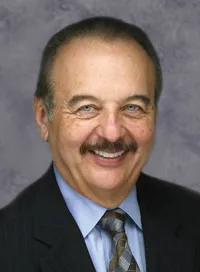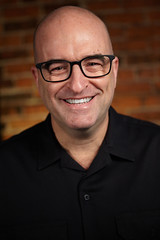
PREV ARTICLE
NEXT ARTICLE
FULL ISSUE
PREV FULL ISSUE
RON GILLIO INTERVIEW, PART ONE
Greg Bennick's latest interview for the Newman Numismatic Portal is with longtime dealer Ron Gillio.
Ron talked about his history in the coin hobby, his experiences traveling overseas to purchase gold coins, the early days of the Long Beach coin show, and interesting topics such as the Here's the first of five parts, where Ron talks about his start in collecting. -Editor GREG BENNICK: Hi, everybody. My name is Greg Bennick. I'm with the Newman Numismatic Portal, and this is yet another in a series of interviews with numismatists from a wide range of backgrounds. And today I'm with Ron Gillio, and we're going to be talking about his career, his background, and how he got his start in numismatics. And I'm really excited for this conversation. Ron, hi, how are you today? RON GILLIO: Greg, I'm fine. This is a great opportunity to tell my story, and thanks for contacting me, and I'm very excited about doing this with you. GREG BENNICK: I'm so glad. And for viewers, Ron has been very patient. We actually set this up two weeks ago, and just as we started the interview, my laptop died. And when I say died, I don't mean that the battery went out. I mean, like into Apple for serious repairs and the whole nine yards. So, Ron has been most patient and most gracious. And Ron, I really appreciate that. Thank you so much. RON GILLIO: No problem. GREG BENNICK: Great. Well, tell me, how did you get your start in the hobby? What got you interested in coins?
And there was a coin dealer I found just around the corner almost from the theater,
Bert Doling. And he was kind of my mentor that I went and talked to him. And he
said,
And what got me really started, he told me, he said, GREG BENNICK: That's amazing. That's fantastic. Now, okay. So, you get started buying two rolls of pennies, you are immediately business-minded in terms of your approach to the hobby. How did that develop from there? You know, some people start with pennies and they're just putting pennies in albums forever, but you immediately got an offer to make a profit on selling these coins. So, how did that develop from there early on?
RON GILLIO: Well, what I did is I bought a blue Whitman album and he actually
gave me one. He said, GREG BENNICK: That is so cool that you already were seeing a progression. Now, given that you were business-minded and making transactions and making some money off of this: did you advertise? Did you go into business? What happened next? RON GILLIO: Well, 1961 was the first coin show I went to. It was at the StatlerHilton Hotel in Los Angeles. It was the Southern California Numismatic Association. It was the biggest shows before the Long Beach show or any shows in California and everybody went to it. I mean, Abe Kosoff and Jerry Cohen and you can name it, Herb Tobias, Lester Merkin, they all went there. And one person that I met in 1963 attending that show was Robert Johnson from San Francisco. And he had this fantastic tray in his showcase, a metal tray with $20, $10, $5, and $2.50 gold pieces in the tray. And I thought that was just fantastic. So, I thought maybe I should buy some gold coins. And I had a little bit of money. And so, I talked to him, got to know him. And he says, just buy one of each, one Liberty and one St. Gaudens. And I don't remember exactly what they were, but I remember giving him $100 and getting change back. There were 40 some odd dollars apiece. So, that kind of started my career in $20 gold pieces. And then I started advertising in the Numismatic Scrapbook magazine, Numismatist, in about the same period of time, early 60s. And then I got into California Fractional Gold and just kind of went on from there. So, I got interested in many different facets of the business and the collecting. GREG BENNICK: Now, I'm just curious, because I'm trying to do the math with inflation and all. At the time, you buy one of each and you get change from $100 bill. Now, granted, coins, these coins were certainly cheaper, but was that a considerable amount of money at the time? Meaning as you spent your $95 on these gold coins, that's the equivalent certainly of hundreds and hundreds of dollars today, but not as much as those coins would cost today. So, you're still putting out quite a bit of money, even though they're much cheaper than they were today. That must have been pretty exhilarating and exciting, I would think, right? RON GILLIO: Oh, it was. I mean, because at the same time, the $20 gold piece was around $50. Like I said, you could buy a two-cent piece or three-cent nickel uncirculated for $15. And of course, they've gone up a lot of value also. But at that same time, I also worked in a market. I was going to high school. I was working in a market as what they call a bag boy, just bagging groceries for people. And I can remember at that time, a loaf of bread was about 25 cents and a quart of milk was about 25 cents. So, you can get kind of perspective here. A $20 gold piece now is around $2,000 here in 2023. And a loaf of bread or gasoline is around $4 or $5. So, it was a lot of money at that time.
To watch the complete video, see:
To read the complete transcript, see:
Wayne Homren, Editor The Numismatic Bibliomania Society is a non-profit organization promoting numismatic literature. See our web site at coinbooks.org. To submit items for publication in The E-Sylum, write to the Editor at this address: whomren@gmail.com To subscribe go to: https://my.binhost.com/lists/listinfo/esylum All Rights Reserved. NBS Home Page Contact the NBS webmaster 
|


